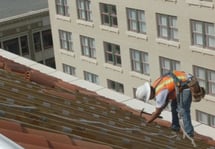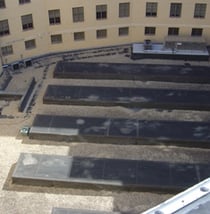Restoring a Piece of Texas History
The Hipolito F. Garcia Federal Building and U.S. Courthouse has seen many ups and downs in its lifetime. It was built in the mid 1930s as part of Franklin Delano Roosevelt’s Federal Public Works program during The Great Depression as a means to relieve widespread unemployment by generating jobs through its construction. In addition to creating job opportunities, the building housed local federal agencies and helped to streamline San Antonio’s growing postal needs.
The historic building is six stories tall with a traditional grand entrance that makes it a skillful example of the French Beaux-Arts style architecture. Constructed of steel and concrete clad in Texas’ finest pink granite and cream limestone, this polygonal-shaped building highlights a recessed porch behind a screen of six monumental Ionic columns rising to support an entablature that continues around the entire building. Located in the Alamo Plaza Historic District, the building is listed on the National Register of Historic Places and serves as the United States District Court for the Southern District. In 2004, the building was renamed in honor of Hipolito Frank Garcia, a San Antonio native who served on the U.S. District Court for the Western District of Texas from 1980 until his death in 2002.
Fast forward to 2011 when, during another economic downturn, the Federal Building is making an impact again on the economy, but this time with its complete renovation and goal to attain LEED Gold certification when the project is complete in mid-March. Chamberlin was awarded the roofing scope of work from general contractor The Beck Group. The 25-year-old roof system was leaking in several places and began to cause
major problems for the building and its occupants.
Chamberlin’s scope of work consisted of refurbishing the existing clay tile mansard roof, installing an internal gutter system and replacing the existing flat roof system to prepare it for a Photovoltaic solar array on level six and a vegetative system on level two all while court is in session.
A Nationally Registered Historic Landmark
Restoring a nationally registered historic building comes with unique challenges,” said Chamberlin Superintendent Jack Vaughn, “and it was very important to perform our work in accordance to their historic preservation standards without disturbing the building occupants’ daily business.”
Chamberlin was ready to tackle the challenging project with Vaughn and Project Manager, Patrick Beasley, at the helm organizing Chamberlin’s action plan. The first priority was to stop the ongoing leaks by installing a temporary roof over the existing one to keep the building dry while it was being restored. The building was occupied during the day, so Chamberlin had to work around the court’s schedule in order to keep the disruptions at a minimum. Anytime Chamberlin needed to mobilize material, to the roof areas, it had to be done on the weekend when the building was closed, which made it extremely important to plan ahead and follow a detailed production schedule. In order to safely mobilize material, Alamo Street was shut down and off-duty police officers helped to keep the area safe while tourists strolled near the work site.
Part of Chamberlin’s scope was to remove 20,000 sq. ft. of mansard clay tiles, replace all underlayment and install new stringers. Each tile was removed, power washed and re-installed to retain the original look as closely as possible. Chamberlin commissioned custom tiles to replace the pieces that were broken in the process and each one was color blended to match the original, historic tiles. With the clay tile roof being six stories high, extra care had to be taken that no tile fell from the roof area during the replacement process. This was one of the major safety challenges Chamberlin faced. To prevent injury, safety nets were installed in the areas where the roofing team was working to keep pedestrians and tenants safe from possible falling debris.
As is sometimes typical of older structures, asbestos was found in portions of the wall flashings and roofing
materials, so an abatement company was brought in to safely remove the affected areas.
Roof Recycling for LEED Points
Roof levels two and six of the building had an existing black EPDM ballasted roof membrane installed directly over a built-up roof system. In order to remove the rock ballast from the roof, Chamberlin employed the use of a vacuum truck and every load of ballast was weighed and recycled to obtain points for LEED certification. In order to remove all ballast in the allotted time of two weekends, a set of mobile truck scales were utilized to track the amount of rock that was removed. Like the ballast rock, Chamberlin recycled the roof membrane and flashings as well. Additionally, Forest Stewardship Council (FSC) certified lumber was used where needed to further enhance the building’s sustainability.
A major logistical challenge was delivering the materials to a roof area constructed on level two, which is an interior recessed roof with the building walls surrounding it on all sides like a bowl. The material could not be  mobilized to the interior roof through the building; therefore, a crane was used to lift the material over the building walls.
mobilized to the interior roof through the building; therefore, a crane was used to lift the material over the building walls.
Chamberlin removed all 42,000 sq. ft. of flat roofing down to the concrete deck and adhered poly ISO insulation. Installed over the insulation area one-half inch cover board and a fully adhered 60 mil TPO single-ply reflective roof membrane. Chamberlin will then install protective slip sheets atop the level two roof to accommodate the vegetative roof system that is being prepared for installation.
The vegetative system, or green roof, will consist of small grasses and shrubs native to the central Texas region and will create an insulating layer that helps reduce building heat, therefore decreasing strain on HVAC systems. Also, rather than shedding rain water to drains, the green roof’s soil will absorb the water to feed plants. Additionally, the green roof will help lower the noise level transmitted through the building and will make great scenery for offices facing the roof area.
A Photovoltaic Team Effort
Chamberlin teamed with Texas Solar Power Company, to install a Photovoltaic (PV) System atop the new roof on level six. The team provided engineering to determine structural attachment requirements for the PV system for wind resistance and weight loading. The building was not originally designed to accommodate solar panel array, so Chamberlin removed the roof system to expose underlying structural elements to allow for the connection of attachment devices. The solar panels will be rack mounted and tilted to maximize the amount of solar power the building will collect.
Once the PV system is connected into the power grid, the owner will obtain the benefit of offset power usage. The 50 kilowatt PV solar panel system can provide enough electricity to power 15 average family homes. Not only will it reduce current utility bills and the building’s carbon footprint, but it can add value to the property.
This project required a team effort from each trade, so every person involved was a key player,” said Project Manager Patrick Beasley. “When a challenge came up, our field operations team quickly found a way to overcome it.” Together with Beck, Chamberlin rose to the occasion and worked hard to limit business interruptions during the roof replacement phase while successfully improving sustainability and contributing LEED points to the historic Hipolito F. Garcia Federal Building.
Subscribe Today!
Stay-in-the-know and subscribe to our blog today!